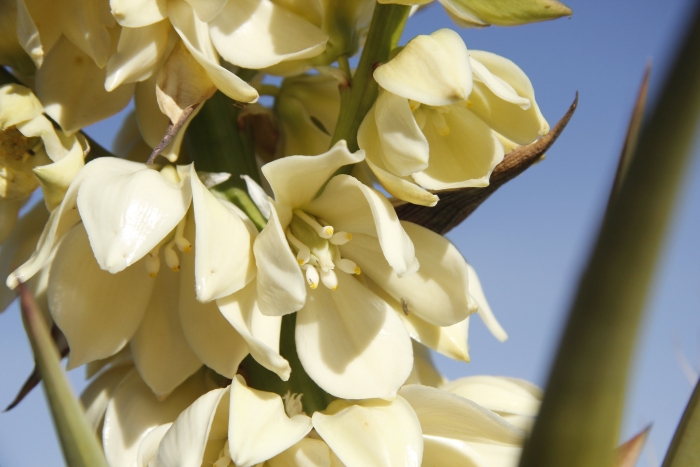Mojave Yucca
(Yucca schidigera)
Mojave Yucca (Yucca schidigera)
/
/

Joshua Tree National Park
Public Domain Mark 1.0
Image By:
Joshua Tree National Park
Recorded By:
Copyright:
Public Domain Mark 1.0
Copyright Notice:
Photo by: Joshua Tree National Park | License Type: Public Domain Mark 1.0 | License URL: https://creativecommons.org/licenses/by/2.0/ | Uploader: Joshua Tree National Park | Publisher: Flickr |





























































Estimated Native Range
Summary
Yucca schidigera, commonly known as Mojave Yucca, is an evergreen succulent native to the deserts of the Southwestern United States and Baja California. This plant is well-adapted to arid environments, often found in sandy plains, gravelly slopes, and desert washes. It can grow up to 16 feet (5 meters) tall, with a dense crown of spirally arranged, bayonet-like leaves that are sharp-tipped and can reach lengths of up to 4 feet. The leaves grow from a conspicuous basal trunk, which is often partially underground. Mojave Yucca blooms from March to April, producing showy clusters of white, bell-shaped flowers, sometimes with a purple tinge, that are pollinated by the yucca moth in a unique mutualistic relationship.
The Mojave Yucca is valued for its striking architectural form and is used in xeriscaping and desert landscaping for its drought tolerance and low maintenance requirements. It is also planted as an accent or specimen plant in rock gardens and modern landscapes. While it requires minimal care, it is important to provide it with well-draining soil and full sun exposure. Overwatering or poor drainage can lead to root rot. Mojave Yucca is also known for its historical use by indigenous peoples for food, fiber, and soap made from its roots. However, it can be toxic to livestock and pets if ingested.CC BY-SA 4.0
The Mojave Yucca is valued for its striking architectural form and is used in xeriscaping and desert landscaping for its drought tolerance and low maintenance requirements. It is also planted as an accent or specimen plant in rock gardens and modern landscapes. While it requires minimal care, it is important to provide it with well-draining soil and full sun exposure. Overwatering or poor drainage can lead to root rot. Mojave Yucca is also known for its historical use by indigenous peoples for food, fiber, and soap made from its roots. However, it can be toxic to livestock and pets if ingested.CC BY-SA 4.0
Plant Description
- Plant Type: Shrubs, Succulents
- Height: 5-15 feet
- Width: 4-5 feet
- Growth Rate: Slow
- Flower Color: Cream, White
- Flowering Season: Spring
- Leaf Retention: Evergreen
Growth Requirements
- Sun: Full Sun
- Water: Very Low, Low
- Drainage: Fast
Common Uses
Bee Garden, Bird Garden, Butterfly Garden, Drought Tolerant, Edible*Disclaimer: Easyscape's listed plant edibility is for informational use. Always verify the safety and proper identification of any plant before consumption., Fire Resistant, Hummingbird Garden, Low Maintenance, Rabbit Resistant, Rock Garden, Showy Flowers, Street Planting
Natural Habitat
native to the deserts of the Southwestern United States and Baja California
Other Names
Common Names: Izote De Ensenada , Spanish Dagger
Scientific Names: Yucca schidigera , Yucca mohavensis , Yucca schindigera , Sarcoyucca mohavensis , Yucca macrocarpa
GBIF Accepted Name: Yucca schidigera Roezl ex Ortgies